## 1、背景介绍
[Eureka](https://link.zhihu.com/?target=https%3A//github.com/Netflix/eureka)是Netflix开源的一款提供服务注册和发现的产品。
其官方文档中对自己的定义是:
> Eureka is a REST (Representational State Transfer) based service that is primarily used in the AWS cloud for locating services for the purpose of load balancing and failover of middle-tier servers. We call this service, the Eureka Server. Eureka also comes with a Java-based client component,the Eureka Client, which makes interactions with the service much easier. The client also has a built-in load balancer that does basic round-robin load balancing.
我们在研发Apollo配置中心时([ctripcorp/apollo](https://link.zhihu.com/?target=https%3A//github.com/ctripcorp/apollo)),考虑到配置中心是基础服务,有非常高的可用性要求,为了更好的支持服务动态扩容、缩容、失效剔除等特性,所以就选择了使用Eureka来提供服务注册和发现功能。
本着“当你选择一款开源产品后,你就应当对它负责,既要信任它又要挑战它”的原则,我花了一些时间比较深入的研究了Eureka的实现细节(好在Eureka的实现短小精悍,通读源码也没花太多时间),今天就来详细介绍一下。
## **2、Why Eureka?**
那么为什么我们在项目中使用了Eureka呢?我大致总结了一下,有以下几方面的原因:
1)它提供了完整的**Service Registry**和**Service Discovery**实现
首先是提供了完整的实现,并且也经受住了Netflix自己的生产环境考验,相对使用起来会比较省心。
2)和**Spring Cloud**无缝集成
我们的项目本身就使用了Spring Cloud和Spring Boot,同时Spring Cloud还有一套非常完善的开源代码来整合Eureka,所以使用起来非常方便。
另外,Eureka还支持在我们应用自身的容器中启动,也就是说我们的应用启动完之后,既充当了Eureka的角色,同时也是服务的提供者。这样就极大的提高了服务的可用性。
这一点是我们选择**Eureka**而不是**zk**、**etcd**等的主要原因,为了提高配置中心的可用性和降低部署复杂度,我们需要尽可能地减少外部依赖。
3)Open Source
最后一点是开源,由于代码是开源的,所以非常便于我们了解它的实现原理和排查问题。
## **3、Dive into Eureka**
相信大家看到这里,已经对Eureka有了一个初步的认识,接下来我们就来深入了解下它吧~
### 3.1 Overview
#### 3.1.1 Basic Architecture
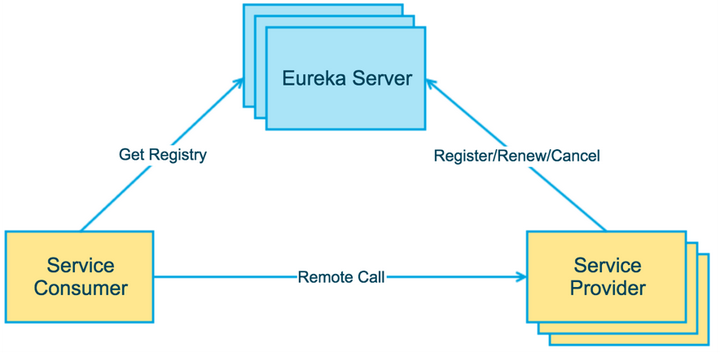图1
上图简要描述了Eureka的基本架构,由3个角色组成:
**Eureka Server**
提供服务注册和发现
**Service Provider**
服务提供方
将自身服务注册到Eureka,从而使服务消费方能够找到
**Service Consumer**
服务消费方
从Eureka获取注册服务列表,从而能够消费服务
需要注意的是,上图中的3个角色都是逻辑角色。在实际运行中,这几个角色甚至可以是同一个实例,比如在我们项目中,Eureka Server和Service Provider就是同一个JVM进程。
#### 3.1.2 More in depth
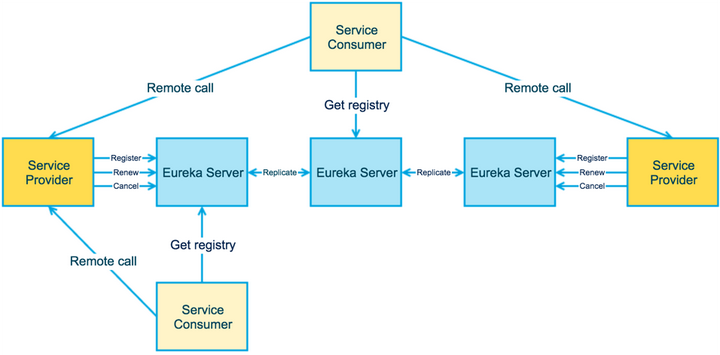图2
上图更进一步的展示了3个角色之间的交互。
1. Service Provider会向Eureka Server做Register(服务注册)、Renew(服务续约)、Cancel(服务下线)等操作。
2. Eureka Server之间会做注册服务的同步,从而保证状态一致
3. Service Consumer会向Eureka Server获取注册服务列表,并消费服务
### 3.2 Demo
为了给大家一个更直观的印象,我们可以通过一个简单的demo来实际运行一下,从而对Eureka有更好的了解。
#### 3.2.1 Git Repository
Git仓库:[nobodyiam/spring-cloud-in-action](https://link.zhihu.com/?target=https%3A//github.com/nobodyiam/spring-cloud-in-action)
这个项目使用了Spring Cloud相关类库,包括:
- [Spring Cloud Config](https://link.zhihu.com/?target=https%3A//cloud.spring.io/spring-cloud-config/)
- [Spring Cloud Eureka (Netflix)](https://link.zhihu.com/?target=https%3A//cloud.spring.io/spring-cloud-netflix/)
#### 3.2.2 准备工作
Demo项目使用了Spring Cloud Config做配置,所以第一步先在本地启动Config Server。
由于项目基于Spring Boot开发,所以直接运行[com.nobodyiam.spring.cloud.in](http://com.nobodyiam.spring.cloud.in/).action.config.ConfigServerApplication即可。
#### 3.2.3 Eureka Server Demo
Eureka Server的Demo模块名是:eureka-server。
#### 3.2.3.1 Maven依赖
eureka-server是一个基于Spring Boot的Web应用,我们首先需要做的就是在pom中引入Spring Cloud Eureka Server的依赖。
> ```text
>
> org.springframework.cloud
> spring-cloud-starter-eureka-server1.2.0.RELEASE
>
> ```
#### 3.2.3.2 启用Eureka Server
启用Eureka Server非常简单,只需要加上@EnableEurekaServer即可。
> ```text
> @EnableEurekaServer
> @SpringBootApplication
> public class EurekaServiceApplication {
> public static void main(String[] args{
> SpringApplication.run(EurekaServiceApplication.class, args);
> }
> }
> ```
做完以上配置后,启动应用,Eureka Server就开始工作了!
启动完,打开[http://localhost:8761](https://link.zhihu.com/?target=http%3A//localhost%3A8761/),就能看到启动成功的画面了。
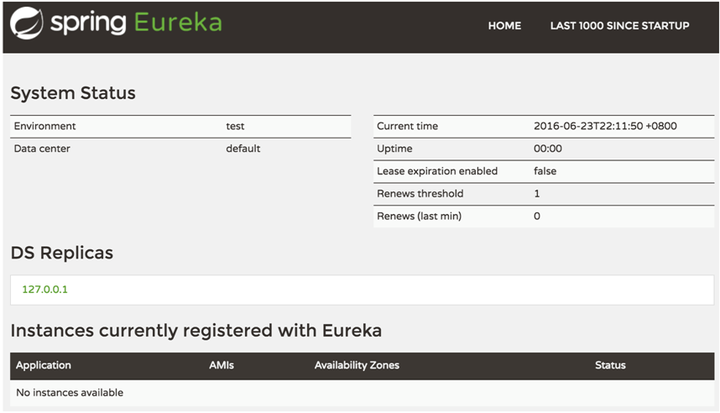图3
#### 3.2.4 Service Provider and Service Consumer Demo
Service Provider的Demo模块名是:reservation-service。
Service Consumer的Demo模块名是:reservation-client。
#### 3.2.4.1 Maven依赖
reservation-service和reservation-client都是基于Spring Boot的Web应用,我们首先需要做的就是在pom中引入Spring Cloud Eureka的依赖。
> ```text
>
> org.springframework.cloud
> spring-cloud-starter-eureka 1.2.0.RELEASE
>
> ```
#### 3.2.4.2 启动Service Provider
启用Service Provider非常简单,只需要加上@EnableDiscoveryClient即可。
> ```text
> @EnableDiscoveryClient
> @SpringBootApplication
> public class ReservationServiceApplication {
> public static void main(String[] args) { newSpringApplicationBuilder(ReservationServiceApplication.class)
> .run(args);
> }
> }
> ```
做完以上配置后,启动应用,Server Provider就开始工作了!
启动完,打开[http://localhost:8761](https://link.zhihu.com/?target=http%3A//localhost%3A8761/),就能看到服务已经注册到Eureka Server了。
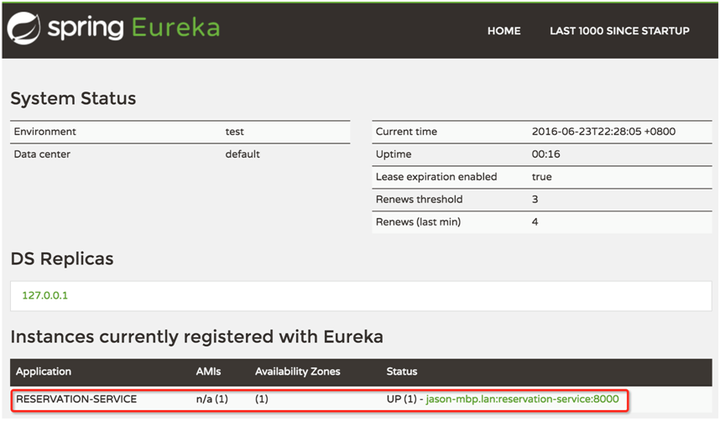图4
#### 3.2.4.3 启动Service Consumer
启动Service Consumer其实和Service Provider一样,因为本质上Eureka提供的客户端是不区分Provider和Consumer的,一般情况下,Provider同时也会是Consumer。
> ```text
> @EnableDiscoveryClient
> @SpringBootApplication
> public class ReservationClientApplication {
> @Bean
> CommandLineRunner runner(DiscoveryClient dc) {
> return args -> {
> dc.getInstances("reservation-service")
> .forEach(si -> System.out.println(String.format(
> "Found %s %s:%s", si.getServiceId(), si.getHost(), si.getPort())));
> };
> }
> public static void main(String[] args) { SpringApplication.run(ReservationClientApplication.class, args);
> }
> }
> ```
上述代码中通过dc.getInstances(“reservation-service”)就能获取到当前所有注册的reservation-service服务。
### 3.3 Eureka Server实现细节
看了前面的demo,我们已经初步领略到了Spring Cloud和Eureka的强大之处,通过短短几行配置就实现了服务注册和发现!
相信大家一定想了解Eureka是如何实现的吧,所以接下来我们继续Dive!首先来看下Eureka Server的几个对外接口实现。
#### 3.3.1 Register
首先来看Register(服务注册),这个接口会在Service Provider启动时被调用来实现服务注册。同时,当Service Provider的服务状态发生变化时(如自身检测认为Down的时候),也会调用来更新服务状态。
接口实现比较简单,如下图所示。
1. ApplicationResource类接收Http服务请求,调用PeerAwareInstanceRegistryImpl的register方法
2. PeerAwareInstanceRegistryImpl完成服务注册后,调用replicateToPeers向其它Eureka Server节点(Peer)做状态同步(异步操作)
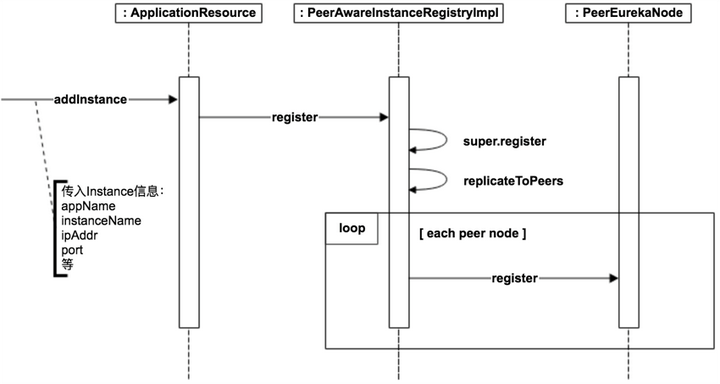图5
注册的服务列表保存在一个嵌套的hash map中:
- 第一层hash map的key是app name,也就是应用名字
- 第二层hash map的key是instance name,也就是实例名字
以[3.2.4.2](https://link.zhihu.com/?target=http%3A//techshow.ctrip.com/archives/1699.html%23service-provider)中的截图为例,RESERVATION-SERVICE就是app name,jason-mbp.lan:reservation-service:8000就是instance name。
Hash map定义如下:
private final ConcurrentHashMap>> registry =new ConcurrentHashMap>>();
#### 3.3.2 Renew
Renew(服务续约)操作由Service Provider定期调用,类似于heartbeat。主要是用来告诉Eureka Server Service Provider还活着,避免服务被剔除掉。接口实现如下图所示。
可以看到,接口实现方式和register基本一致:首先更新自身状态,再同步到其它Peer。
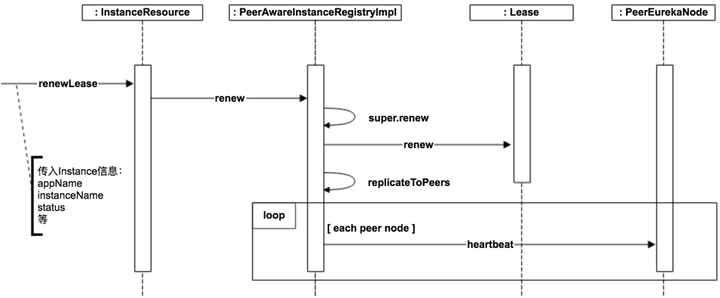
图6
#### 3.3.3 Cancel
Cancel(服务下线)一般在Service Provider shut down的时候调用,用来把自身的服务从Eureka Server中删除,以防客户端调用不存在的服务。接口实现如下图所示。
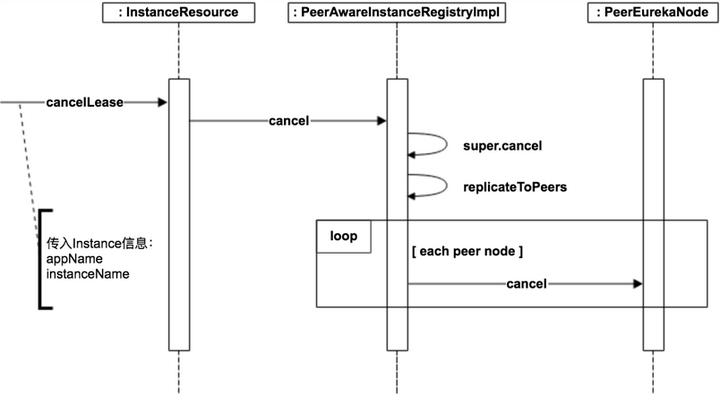图7
#### 3.3.4 Fetch Registries
Fetch Registries由Service Consumer调用,用来获取Eureka Server上注册的服务。
为了提高性能,服务列表在Eureka Server会缓存一份,同时每30秒更新一次。
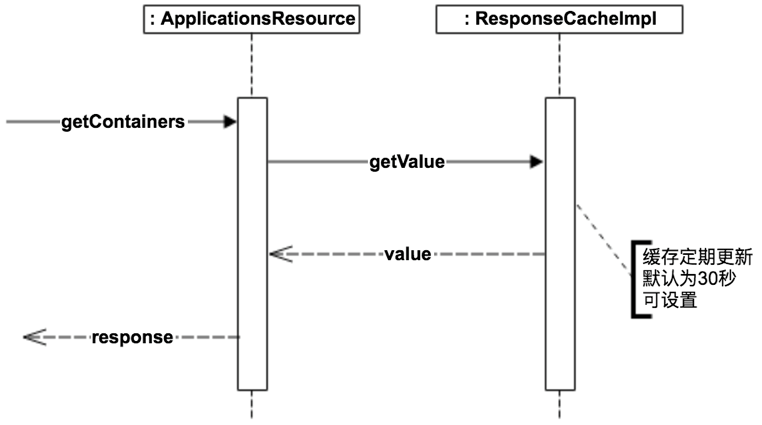图8
#### 3.3.5 Eviction
Eviction(失效服务剔除)用来定期(默认为每60秒)在Eureka Server检测失效的服务,检测标准就是超过一定时间没有Renew的服务。
默认失效时间为90秒,也就是如果有服务超过90秒没有向Eureka Server发起Renew请求的话,就会被当做失效服务剔除掉。
失效时间可以通过eureka.instance.leaseExpirationDurationInSeconds进行配置,定期扫描时间可以通过eureka.server.evictionIntervalTimerInMs进行配置。
接口实现逻辑见下图:
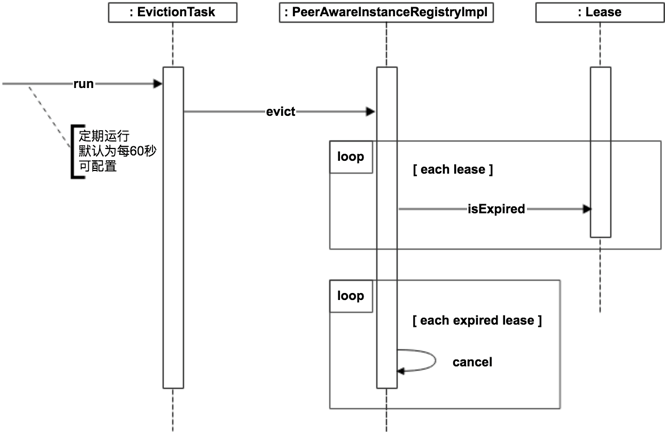图9
#### 3.3.6 How Peer Replicates
在前面的Register、Renew、Cancel接口实现中,我们看到了都会有replicateToPeers操作,这个就是用来做Peer之间的状态同步。
通过这种方式,Service Provider只需要通知到任意一个Eureka Server后就能保证状态会在所有的Eureka Server中得到更新。
具体实现方式其实很简单,就是接收到Service Provider请求的Eureka Server,把请求再次转发到其它的Eureka Server,调用同样的接口,传入同样的参数,除了会在header中标记isReplication=true,从而避免重复的replicate。
Peer之间的状态是采用异步的方式同步的,所以不保证节点间的状态一定是一致的,不过基本能保证最终状态是一致的。
结合服务发现的场景,实际上也并不需要节点间的状态强一致。在一段时间内(比如30秒),节点A比节点B多一个服务实例或少一个服务实例,在业务上也是完全可以接受的(Service Consumer侧一般也会实现错误重试和负载均衡机制)。
所以按照CAP理论,Eureka的选择就是放弃C,选择AP。
#### 3.3.7 How Peer Nodes are Discovered
那大家可能会有疑问,Eureka Server是怎么知道有多少Peer的呢?
Eureka Server在启动后会调用EurekaClientConfig.getEurekaServerServiceUrls来获取所有的Peer节点,并且会定期更新。定期更新频率可以通过eureka.server.peerEurekaNodesUpdateIntervalMs配置。
这个方法的默认实现是从配置文件读取,所以如果Eureka Server节点相对固定的话,可以通过在配置文件中配置来实现。
如果希望能更灵活的控制Eureka Server节点,比如动态扩容/缩容,那么可以override getEurekaServerServiceUrls方法,提供自己的实现,比如我们的项目中会通过数据库读取Eureka Server列表。
具体实现如下图所示:
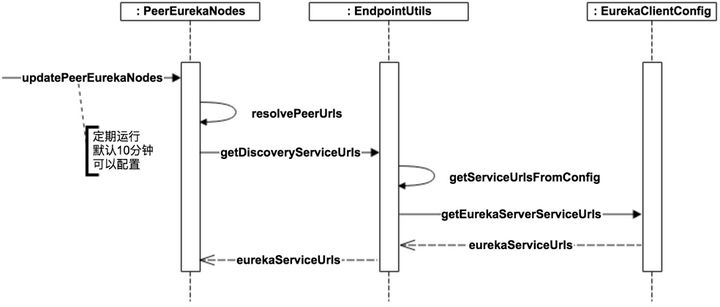图10
#### 3.3.8 How New Peer Initializes
最后再来看一下一个新的Eureka Server节点加进来,或者Eureka Server重启后,如何来做初始化,从而能够正常提供服务。
具体实现如下图所示,简而言之就是启动时把自己当做是Service Consumer从其它Peer Eureka获取所有服务的注册信息。然后对每个服务,在自己这里执行Register,isReplication=true,从而完成初始化。
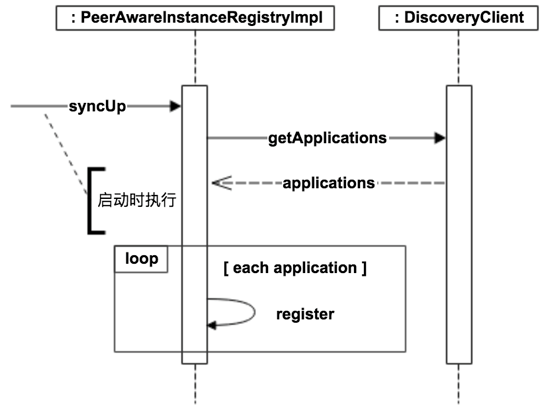图11
### 3.4 Service Provider实现细节
现在来看下Service Provider的实现细节,主要就是Register、Renew、Cancel这3个操作。
#### 3.4.1 Register
Service Provider要对外提供服务,一个很重要的步骤就是把自己注册到Eureka Server上。
这部分的实现比较简单,只需要在启动时和实例状态变化时调用Eureka Server的接口注册即可。需要注意的是,需要确保配置eureka.client.registerWithEureka=true。
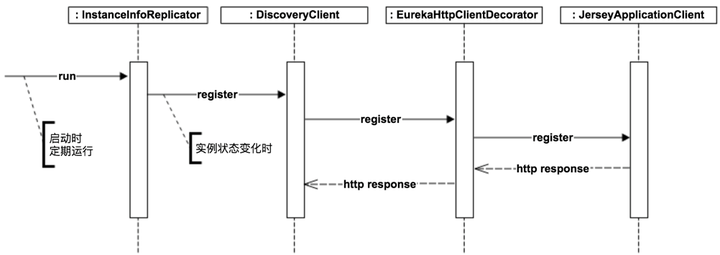图12
#### 3.4.2 Renew
Renew操作会在Service Provider端定期发起,用来通知Eureka Server自己还活着。 这里有两个比较重要的配置需要注意一下:
1. instance.leaseRenewalIntervalInSeconds
Renew频率。默认是30秒,也就是每30秒会向Eureka Server发起Renew操作。
1. instance.leaseExpirationDurationInSeconds
服务失效时间。默认是90秒,也就是如果Eureka Server在90秒内没有接收到来自Service Provider的Renew操作,就会把Service Provider剔除。
具体实现如下:
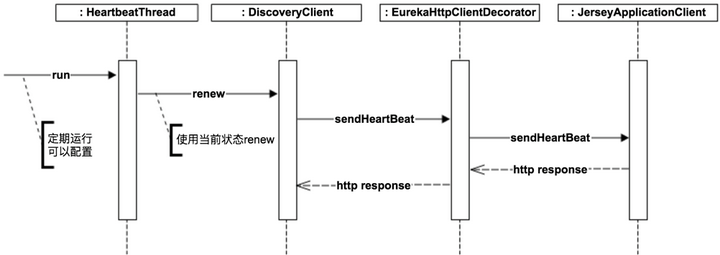图13
#### 3.4.3 Cancel
在Service Provider服务shut down的时候,需要及时通知Eureka Server把自己剔除,从而避免客户端调用已经下线的服务。
逻辑本身比较简单,通过对方法标记@PreDestroy,从而在服务shut down的时候会被触发。
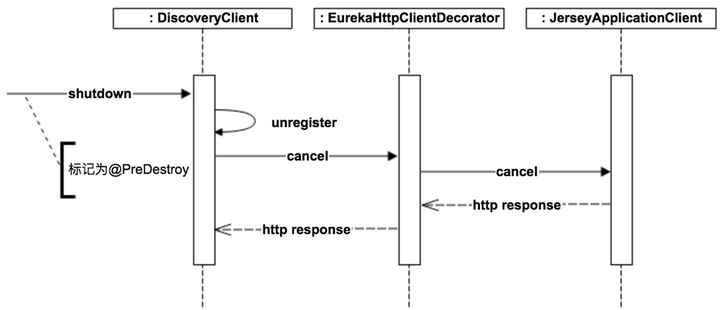图14
#### 3.4.4 How Eureka Servers are Discovered
这里大家疑问又来了,Service Provider是怎么知道Eureka Server的地址呢?
其实这部分的主体逻辑和3.3.7 How Peer Nodes are Discovered几乎是一样的。
也是默认从配置文件读取,如果需要更灵活的控制,可以通过override getEurekaServerServiceUrls方法来提供自己的实现。定期更新频率可以通过eureka.client.eurekaServiceUrlPollIntervalSeconds配置。
图15
### 3.5 Service Consumer实现细节
Service Consumer这块的实现相对就简单一些,因为它只涉及到从Eureka Server获取服务列表和更新服务列表。
#### 3.5.1 Fetch Service Registries
Service Consumer在启动时会从Eureka Server获取所有服务列表,并在本地缓存。需要注意的是,需要确保配置eureka.client.shouldFetchRegistry=true。
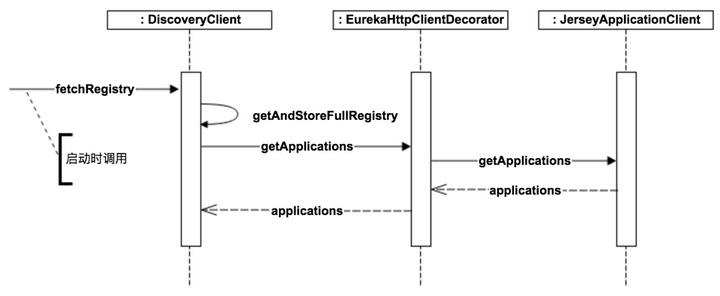图16
#### 3.5.2 Update Service Registries
由于在本地有一份缓存,所以需要定期更新,定期更新频率可以通过eureka.client.registryFetchIntervalSeconds配置。
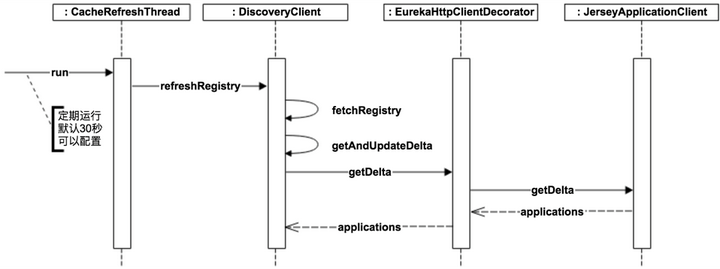图17
#### 3.5.3 How Eureka Servers are Discovered
Service Consumer和Service Provider一样,也有一个如何知道Eureka Server地址的问题。
其实由于Service Consumer和Service Provider本质上是同一个Eureka客户端,所以这部分逻辑是一样的,这里就不再赘述了。详细信息见3.4.4节。